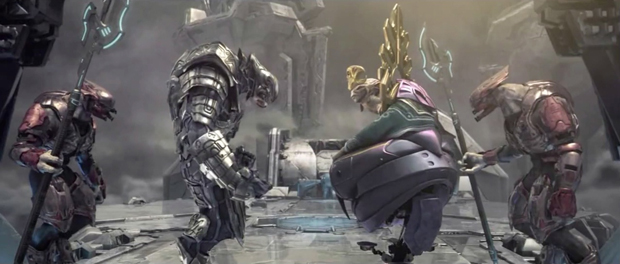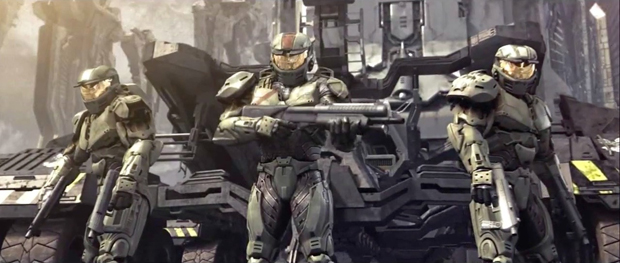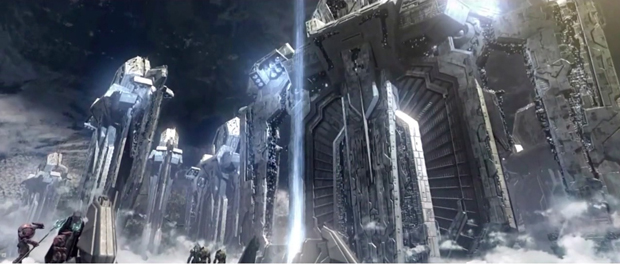More Weight (Page Three)
Even with the aforementioned overview to go by, one can see that this particular chapter in the fiction of Halo is no pushover. In many ways Halo Wars’ story both meets the lofty ideals set by Bungie Studios and falls short of them. The real surprise for fans of Halo’s fiction are the certain points when the title actually goes above and beyond all previous expectations, and, make no mistake about it, Halo Wars does this on several fronts.
As with any story, the heart and soul lies in the characters; and for Halo Wars, it’s no different. While there are no iconic archetypes which hearken from ancient fables and biblical tales, like that of the original Arbiter for example, the characters in Halo Wars are immediately recognizable and effective in their roles. Like the majority of characters in the trilogy – the silent gunslinger persona of the Master Chief and the shit-talking, joke-dropping Marine of Sergeant Johnson – Halo Wars’ characters all fall within the somewhat cliché but reasonably expected department of contemporary science fiction archetypes.
Cutter is the typical, hard-nosed captain with a strong personality, but one that often favors certainty and predictability over chance. His character is forced to evolve when Anders is snatched away by the Covenant, requiring him to pursue the professor into Covenant-controlled space. Anders, on the other hand, is far less grounded. Although she clearly has a capable intellect, playing the typical scientist-with-a-plan role, her direction is much more risk-driven, as she reminds us more than once that “Nothing ventured [is] nothing gained.”
The real attitude of Halo Wars comes in two flavors: Forge and the AI construct known as Serina. The former is the typical Marine model we’ve come to know from Aliens and Halo; he’s strong-willed and determined, yet oftentimes adolescent. Serina, taking notes from Cortana, definitely has an inkling for sarcasm, but her approach is often much more dry and sardonic, painting her considerably darker than her predecessor.

The enemies of the game are the Arbiter and the Prophet of Regret, both two sides of the same coin. Unlike Thel ‘Vadam of Halo 2 and Halo 3, Ripa ‘Moramee is a significantly different kind of Arbiter. Halo Wars’ take on this role is less assassin, as was with Halo 2, and more high-ranking general — here the Arbiter is commanding troops into battle and making large-scale decisions. This is an interesting variant, given his vicious and heartless nature. The Prophet of Regret, though previously represented as the bungling hierarch who botched the invasion of Earth, is much shrewder this time around. And if the Arbiter is the ask-no-questions blood hound, than Regret is the poised and strategic task master — both of which are common to the class of contemporary science fiction personas.
There’s nothing new here, so players can almost immediately recognize who is who and begin to take in the story from the very start of the campaign.
The unfortunate side effect of this immediacy is that while being accessible to most players, there’s little room for further character development. What’s more is that the dialogue is often so cliché and typical of their prescribed personalities, that it becomes somewhat painful to watch. That’s not to say that the story is poor or that the writing is of a mid-grade sci-fi novel formula, but only that there are key moments which could have been used to develop characters but are instead used to firmly ensconce them in their rather average roles, sometimes even with lines sporting an immense amount of cringe-worthiness.
But on behalf of the characters, the extended fiction imbedded in Halo Wars does it a fair amount justice. Within the campaign menu we find one of the treasures of the title: Halo Wars offers a feature called “Timeline.” In this section of the game’s menu, we find a scrollable timeline replete with unlockable entries from as early as 2498 to the year of the original trilogy, 2552. And herein not only do we get ancillary fiction, but certain characters also find a significant amount of depth, not too dissimilar to the buried tales found within Halo 3’s terminals, which added weight to the overall Forerunner narrative of the trilogy.
For example, just before leaving Arcadia, Cutter is told by one of the Spartans that Anders, in the hands of the Covenant, is a severe security risk and should be fired upon – to which Forge gives a cold stare. This suggestion is revisited in the Timeline, as we discover that afterward, there was a brief altercation between Forge and Spartan-042 on this same issue — which resulted in damage done to the interior of the Spirit of Fire. In the end we see that there was a level of respect gained between Forge and the Spartans which resonates much later in the campaign, when the sergeant orders them to return back to the Spirit — in their stead, he would personally overload the FTL drive, sacrificing his life rather than the Spartans’.

It is here that we find one of the game’s true gems: the Spartans. They are not main characters by any stretch, but their small sequences are visually powerful, and in some ways they even eclipse what we’ve seen and read about the Spartans in both the trilogy and novels. The Anders discussion exemplifies the matter-of-fact nature we expect and anticipate from the Spartans and Halo Wars’ story, as a whole, does quite will in this respect.
The game’s Timeline feature doesn’t stop there, though. In it, we discover that Anders is at odds with her mother, which is particularly interesting when looked at alongside two other sources: the game’s manual, and Halo Wars: Genesis. Both of these echo the Timeline’s description of Anders’ relationship with her mother, except they speak of an identical relationship that Anders holds with Dr. Catherine Halsey — the progenitor of the Spartan-II program. This leads us to believe that Anders might be Halsey’s daughter and that her father, someone to whom she sends encrypted messages of her findings to while aboard the Spirit of Fire, is also someone of interest — possibly someone we already know.
With the Arbiter, we also see a considerable level of depth provided in his own backstory. The character is advertised as fanatical and insane, but prefacing our experience with him during the game, the knowledge that he failed to effect a coup d’etat and became a criminal adds another dimension to his perspective. From this subverted squalor of captivity, the Arbiter rises to a lofty position as leader of the Covenant’s preeminent military campaign — not only for their charge against humanity, but also their pivotal and renewed focus on the power of the ancient relics.
So despite the grating dialogue and frustrating one-liners throughout the campaign, the characters’ supplemental backstory details provided in the Timeline and in Halo Wars: Genesis create a compelling and intriguing history for them — ultimately enhancing the overall campaign experience.
And what of the story itself — how does it stack up against the existing fiction and the Halo trilogy?
Even a cursory understanding of the plot shows that it follows the same story premise of the previous three games: the Covenant want to use the Forerunner technology to crush humanity and the humans want to destroy the technology to avoid their own extinction. But, as was fully conveyed earlier in this piece, as complex as Halo Wars can be when taking in all of its disparate parts, its basic narrative is much easier to follow than those of the original trilogy. This makes it more effective for a new audience, while the Timeline, Halo Wars: Genesis, the game’s manual and the website provide extraneous depth for the older, seasoned fans of Halo’s fiction.
The title truly excels in a handful of areas which both continue the Halo tradition effectively and, at some rare junctures, improve on it — but it is definitely far from perfect. Before we discuss where Halo Wars hits its snags, let’s talk about where it succeeds.

The first thing players will immediately notice is the cinematics. Fashioned by Blur Studios, these CG cutscenes are by far the most impressive we’ve seen in the Halo trilogy. Visually they are captivating and elegantly crafted, coming as close to a Halo film as has ever been done before. While all of the cinematics are of high-quality, a handful are absolutely unbelievable, including “Descent” where the sheer scale of the Spirit of Fire set against a backdrop of the shield world is manifested; and “Monsters” in which we see Forge and the three Spartans defend the FTL drive from a torrent of Sangheili Honor Guards led by the Arbiter. The cut scenes in Halo Wars are so impressive that they appropriately warranted their own section of the campaign menu.
The second main attractant of the campaign is its connections to the extended fiction, and in this way it absolutely surpasses all previous attempts, even those by Bungie. While the trilogy is the quintessential Halo experience, the volume of information offered in Halo Wars through its Timeline feature, and in the general homage it pays novels like Halo: Ghosts of Onyx and Halo: Contact Harvest is unprecedented. Typically, Halo games have been fashioned to remain independent from the extended universe, abstaining from almost every possible reference, but in Halo Wars, Ensemble has managed to embrace these elements without making the game’s main narrative reliant upon it. The result is the majestic shield world and the historic planet of Harvest — two of the most interesting environments in any Halo game.
A third reason the campaign in Halo Wars does extremely well is its art and design. Halo’s history is one filled with phenomenal visuals that are keyed from a stylized perspective. Halo Wars is no different. Whether we’re looking at the Spartans’ marred but gloriously vibrant Mjolnir armor which heavily resembles those from the Greco-Roman eras or the unprecedented and expansive majesty of the Forerunner shield world and its fleet of warships, Halo Wars effectively captures the same tangible vividness we’ve come to enjoy in the previous games. What’s more is that there are set pieces which absolutely swallow those from the past in both scale and intensity. The rise of the Spirit of Fire into the shield world, the choreography of the UNSC’s last bout with the Arbiter and the Honor Guard and even the awakening of the massive Forerunner dreadnoughts: they all compliment the design direction pioneered by Bungie and provide a handful of exclamation points for the player.